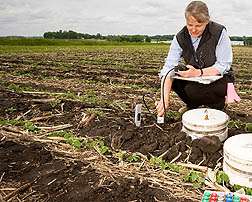Reducing Agriculture's Climate Change Footprint

(PhysOrg.com) -- Curbing greenhouse gas emissions from cultivated fields may require going beyond cutting back on nitrogen fertilizer and changing crop rotation cycles, according to research by Agricultural Research Service (ARS) scientists.
Jane Johnson, a soil scientist at the ARS North Central Soil Conservation Research Laboratory in Morris, Minn., is looking for practical ways to keep carbon in the soil and reduce greenhouse gas emissions.
In a comprehensive study, she raised corn, soybean, wheat and alfalfa in rotation so that each crop grew in the same year, on plots treated with and without fertilizer. She also used a less-aggressive tillage system known as strip tillage, in which only narrow bands of soil are tilled instead of an entire field. For comparison, she replicated the cropping system adopted by many Minnesota farmers-raising corn and soybeans in a two-year cycle on fertilized plots tilled with a chisel or moldboard plow.
She used a hydraulic soil probe to measure the organic carbon sequestered in the soil, and closed-vented chambers to measure emissions of carbon dioxide, methane, and nitrous oxide. She found that when measured over the course of a year, greenhouse gas releases were largely the same under two-year and four-year rotation systems, and that applying nitrogen fertilizer had less overall impact than anticipated on nitrous oxide emissions. Nitrous oxide emissions peaked during spring thaws when the sun warmed the soil, regardless of which tillage or rotation system was used.
Chisel and moldboard plowing increased carbon dioxide emissions for a short time. But measured over the course of a year, carbon dioxide emissions were no different from plots with intensive tillage than plots without it. She also found no consistent patterns to methane releases.
Johnson's work is part of a five-year ARS project known as GRACEnet (Greenhouse gas Reduction through Agricultural Carbon Enhancement network) in which researchers at more than 32 sites are examining strategies to help reduce agriculture's climate change footprint. The project supports the U.S. Department of Agriculture priority of responding to climate change.
More information: Read more about this research in the November/December 2009 issue of Agricultural Research magazine.
Provided by USDA Agricultural Research Service















